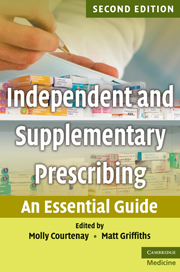Book contents
- Frontmatter
- Contents
- List of contributors
- Foreword to the second edition
- Preface to the second edition
- 1 Non-medical prescribing: an overview
- 2 Non-medical prescribing in a multidisciplinary team context
- 3 Consultation skills and decision making
- 4 Legal aspects of independent and supplementary prescribing
- 5 Ethical issues in independent and supplementary prescribing
- 6 Psychology and sociology of prescribing
- 7 Applied pharmacology
- 8 Monitoring skills
- 9 Promoting concordance in prescribing interactions
- 10 Evidence-based prescribing
- 11 Extended/supplementary prescribing: a public health perspective
- 12 Calculation skills
- 13 Prescribing in practice: how it works
- 14 Minimising the risk of prescribing error
- Index
- References
9 - Promoting concordance in prescribing interactions
Published online by Cambridge University Press: 10 January 2011
- Frontmatter
- Contents
- List of contributors
- Foreword to the second edition
- Preface to the second edition
- 1 Non-medical prescribing: an overview
- 2 Non-medical prescribing in a multidisciplinary team context
- 3 Consultation skills and decision making
- 4 Legal aspects of independent and supplementary prescribing
- 5 Ethical issues in independent and supplementary prescribing
- 6 Psychology and sociology of prescribing
- 7 Applied pharmacology
- 8 Monitoring skills
- 9 Promoting concordance in prescribing interactions
- 10 Evidence-based prescribing
- 11 Extended/supplementary prescribing: a public health perspective
- 12 Calculation skills
- 13 Prescribing in practice: how it works
- 14 Minimising the risk of prescribing error
- Index
- References
Summary
The introduction and expansion of non-medical prescribing is part of modernising the health service to make it accessible and responsive to patient needs. Increasing numbers of nurses, pharmacists and allied health professionals are now exercising their prescribing powers across a wide range of healthcare settings, and, since 2006, prescribing across the range of formulary medicines. This increases the points of access that patients have for obtaining medicines. However, gaining access to medicines from practitioners is unlikely to improve patients' health per se. Increasing access must be combined with a prescribing consultation in which the communication and interaction that occurs enables patients to take their medicines effectively to benefit their health.
Using the evidence base for effective prescribing, when effectiveness is measured in terms of potential health benefit, must include not only a consideration of the pharmacological evidence, but also the communication with patients that is required for effective medicine taking. The communication processes and attitudinal principles that are believed to embody an effective partnership model of prescribing are known as ‘concordance’.
This chapter gives an overview of the evidence base for the concept of concordance and draws out the implications from research for the new generation of prescribers. It will begin by defining concordance and tracing its history and relationship to the concepts of ‘compliance’ and ‘adherence’. A review of research into both compliance and concordance is followed by an outline of the reasons why practitioners who are independent (IPs) and/or supplementary prescribers (SPs) need to incorporate the principles of concordance into their practice.
- Type
- Chapter
- Information
- Independent and Supplementary PrescribingAn Essential Guide, pp. 107 - 118Publisher: Cambridge University PressPrint publication year: 2010



